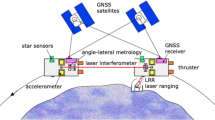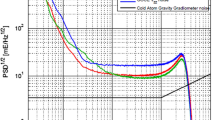Abstract
What type of gravity satellite mission is required for the time after GRACE and GOCE? Essentially, the variables at our disposal are experiment altitude, compensation of attenuation by differential measurement and measurement precision. The latter depends on the performance of the complete sensor system and involves items such as required dynamic range, baseline length, sensor type (ambient temperature or cryogenic), number of test masses, etc.
Before any mission profile is to be studied the science issues to be addressed by GRACE and GOCE follow-on missions need to be clarified. Whether further improvement of the quasi-stationary part of the gravity fields is needed depends on the needs in solid earth physics, oceanography and geodesy and on the availability and quality of complementary data. Complementary data are also the key to the adequate use of measurements of temporal variations of gravity, apart from issues such as spatial and temporal data coverage.
Similar content being viewed by others
References
Cazenave, A. and Nerem, R. S.: 2002, ‘Redistributing Earth's mass’, Science 297, 783-784.
Colombo, O. L. and Chao, B. F.: 1993, ‘Global Gravitational Change from Space in 2010’, in H. Montag and Ch. Reigber (eds.), Geodesy and Physics of the Earth, IAG-Symposia 112, Springer, Heidelberg, pp. 71-75.
Colombo, G., Arnold, D. A., Binsack, J. H., Gay, R. H., Grossi, M. D., Lauman, D. A., Orringer, O.: 1976, ‘Dumbell Gravity-Gradient Sensor: A New Application of Orbiting Long Tethers’, Reports on Geoastronomy 2, Smithonian Astrophysical Observatory, Cambridge, Ma., 59 pp.
Committee on Earth Gravity from Space: 1997, Satellite Gravity and the Geosphere, National Academy Press, Washington, D.C., 112 pp.
Cox, C. M. and Chao, B. F.: 2002, ‘Detection of a large scale mass redistribution in the terrestrial system since 1998’, Science 297, 831-833.
Drinkwater, M. R., Floberghagen, R. F., Haagmans, R., Muzi, D., Popescu, A.: 2003, ‘GOCE: ESA's First Earth Explorer Core Mission’, Space Sci. Rev., this volume.
ESA: 1999, Gravity Field and Steady-State Ocean Circulation Mission, ESA SP-1233(1), ESA Publications Division, Noordwijk, 217 pp.
Forward, R. L.: 1974, ‘Review of Artificial Satellite Gravity Gradiometer Techniques for Geodesy’, in G. Veis (ed.), Proc. Intern. Symp. on the Use of Artificial Satellites for Geodesy and Geodynamics, Publ. National Technical University, Athens, pp. 157-192.
King, S. D.: 2002, ‘Geoid and topography over subduction zones: The effect of phase transformations’, JGR 107,B1, ETG 2-1-2-10.
Lithgow-Bertelloni, C., Richards, M. A.: 1998, ‘The dynamics of cenozoic and mesozoic plate motions’, Reviews of Geophysics 36,1, 27-78.
Lumley, J. M., White, J. P., Barnes, G., Huang, D., Paik, H. J.: 2002, ‘A Superconducting Gravity Gradiometer Tool for Exploration’, unpublished manuscript.
Negredo, A. M., Carminati, E., Barba, S., Sabadini, R.: 1999, ‘Dynamic Modelling of Stress Accumulation in Central Italy’, Geophys. Res. Letters 26,13, 1945-1948.
Open University Course Team: 1989, G. Bearman (ed.), Ocean Circulation, Butterworth-Heinemann, Oxford, 238 pp.
Paik, H. J. and Richard, J.-P.: 1986, Development of a Sensitive Superconducting Gravity Gradiometer for Geological and Navigational Applications, NASA Contracter Report 4011.
Rummel, R.: 1986, ‘Satellite Gradiometry’, in H. Sünkel (ed.), Mathematical and Numerical Techniques in Physical Geodesy, Lecture Notes in Earth Sciences 7, Springer, Berlin, pp. 318-363.
Rummel, R., and van Gelderen, M.: 1992, ‘Spectral Analysis of the Full Gravity Tensor’, Geophys. J. Int. 111,1, 159-169.
Simons, M. and Hager, B. H.: 1997, ‘Localization of the gravity field and the signature of glacial rebound’, Nature 390, 500-504.
Snadden, M. J., McGuirk, J. M., Bayer, P., Haritos, K. G., Kasevich, M. A.: 1998, ‘Measurement of the Earth's Gravity Gradient with an Atom Interferometer-Based Gravity Gradiometer’, Physical Review Letters 81,5, 971-974.
Snieder, R. and Trampert, J.: 2000, ‘Linear and nonlinear inverse problems’, in A. Dermanis, A. Grün, and F. Sanso (eds.), Geomatic Methods for the Analysis of Data in the Earth Sciences, Lecture Notes in Earth Sciences 95, Springer, Berlin, pp. 93-164.
Touboul, P.: 2003, ‘Microscope instrument development, lessons for GOCE’, Space Sci. Rev., this volume.
Vermeersen, B.: 2003, ‘The potential of GOCE in constraining the structure of the crust and lithosphere from post-glacial rebound’, Space Sci. Rev., this volume.
Wells, W. C.,(ed.): 1984, Spaceborne Gravity Gradiometers, NASA Conference Publications, Scientific and Technical Information Branch, pp. 86.
Williamstown Report: 1969, The Terrestrial Environment. Solid-Earth and Ocean Physics, Applications of Space and Astronomic Techniques, Report of a study at Williamstown, Mass. NASA.
Zarembinski, S.: 2003, ‘On supercondutive gravity gradiometry in Space’, Space Sci. Rev., this volume.
Zerbini, S., Achache, J., Anderson, A. J., Arnet, F., Geiger, A., Klingelé, E., Sabadini, R., Tinti, S.: 1992, Study of Geophysical Impact of High-Resolution Earth Potential Field Information, ESA-study, final report, pp. 282.
Author information
Authors and Affiliations
Rights and permissions
About this article
Cite this article
Rummel, R. How to Climb the Gravity Wall. Space Science Reviews 108, 1–14 (2003). https://doi.org/10.1023/A:1026206308590
Issue Date:
DOI: https://doi.org/10.1023/A:1026206308590




